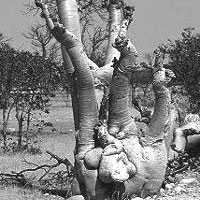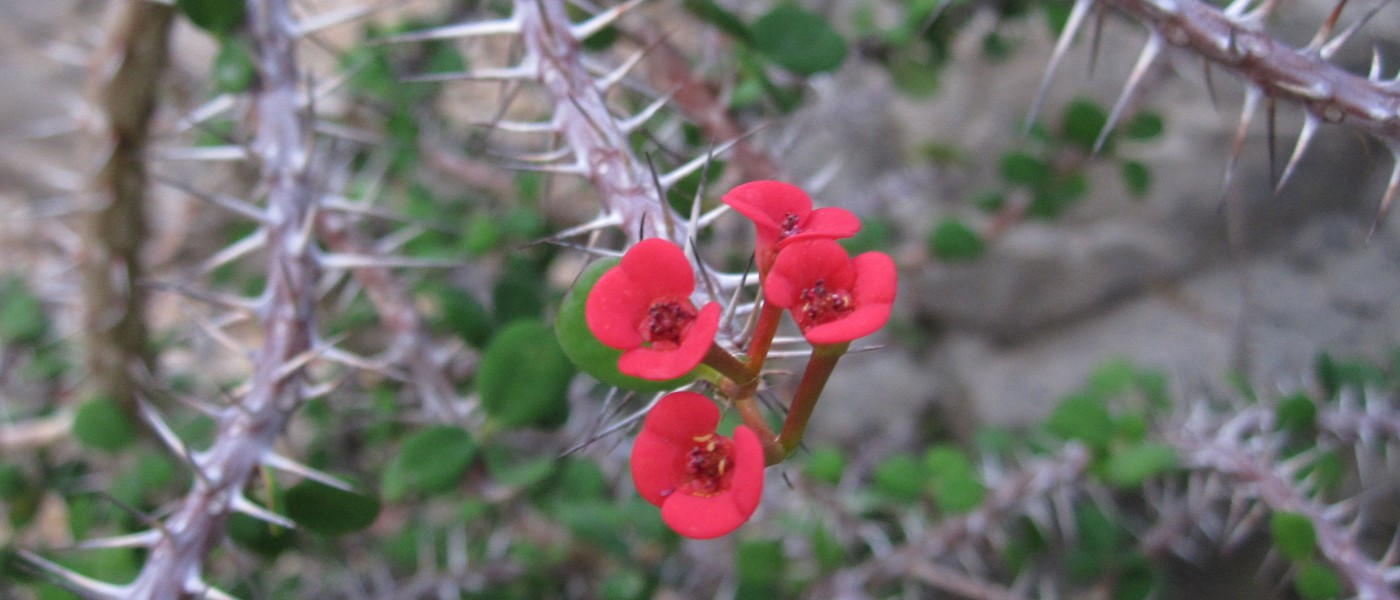Succulent Bonsai: Capturing the Spirit of the Desert
Succulent plants are fascinating in their diversity of form. In the wild, they range from towering trees, such as Moringa ovalifolia, to inch-high "living stones," like Lithops karasmontana. Many succulents, such as aloes, sedums, and kalanchoes, have become staples in the American garden and home.
Now there is growing interest in applying bonsai techniques to succulents. Though it may seem like an odd matchup, bonsai practice can contribute much to our knowledge of succulent species, and succulents make interesting and unusual additions to bonsai collections.

Bonsai is an ancient art form that seeks to re-create nature in miniature. It was born out of a deep appreciation for the natural world and a desire to convey the spiritual power and beauty of the larger landscape to more confined domestic spaces. Its practitioners developed proven methods for pruning and shaping plant pecimens to exhibit the forms of adult trees molded by their natural environments.
There are many reasons why succulents make ideal subjects for bonsai. Native to tropical and semitropical arid regions around the globe, many species are naturally small or undergo "dwarfing" in the wild due to harsh conditions. Growing slowly from crevices and rocky ground and enduring abrasive winds, erratic water supply, dramatic fluctuations in daily temperature, browsing by animals, bright sunlight, and thin, fast-draining soil, mature succulents can actually end up looking like bonsai.
Succulents also have unique morphological features that make them appealing to bonsai artists, namely their fleshy leaves, swollen trunks, and thickened bases—adaptations that enable the plants to store excess water for use during dry periods. What's more, many have interesting leaves, wonderful bark texture and color, beautiful flower displays, or dramatic shapes when dormant and leafless. Some succulents are pleasantly aromatic.
Creating a Succulent Bonsai
There are roughly 10,000 succulent species altogether, distributed through 60 different plant families. Their diversity of form offers an abundance of interesting bonsai options. In nature, succulents follow such bonsai styles as broom, informal upright, slanted, prostrate, semicascade, windswept, literati, and grotesque. Bonsai artists are also creating new interpretations of these traditional stylistic models based on the growth habits of succulent species.
When choosing succulent stock for bonsai, look for some of the same characteristics you would when choosing for traditional bonsai. Specimens should be healthy and well established. Desirable features include slow growth, small leaf and stem internodes (spaces between individual leaves or branches), and long life-span potential. Look for interesting habit, foliage texture, branch formation, flowers, fruit, and so on. Ideal candidates will also demonstrate good recovery after transplanting, good response to pruning (sprouting new growth), and an ability to grow in a confined container.
Prune according to established bonsai recommendations to encourage Y-shaped branching and proportionately smaller internodes. (For information on basic pruning techniques, as well as other general information on bonsai growing, consult the publications and web sites listed in "General Bonsai Information.") Pruning may prevent flowering the following season or until new growth has been established.
Root pruning may not be needed and is generally not recommended for succulents. Succulent roots are rarely vigorous when pruned, so the less disruption the better. If roots must be trimmed for aesthetic reasons, remove all soil, keep the wounds dry until they are completely scarred over, and then replant. Moisture on open wounds almost certainly invites rot. Very large cuts may require several weeks to heal.
Succulents can be carefully wired using aluminum wire, which is more pliable than copper. Wire may need to be left on for long periods of time because succulents are generally slow growing.
Follow the same recommendations for selecting containers as with traditional and tropical bonsai. Above all, ensure good drainage. Drill additional holes, if necessary, and cover holes with open, nonclogging screens.
Succulents may be staged as individual bonsai, forests, companion plants, or in landscape trays. Avoid planting species with different growing requirements together in the same container. Use rocks for propping and stabilizing, and use wire ties to secure plants to the container. As a top covering, use crushed rock, haydite (a shale/clay aggregate), or gravel; moss should not be used because it does not typically grow with desert plants and thus presents an unnatural setting.
Caring for Succulents
Growing succulents as bonsai specimens requires an understanding of—and an ability to re-create—the conditions of their native habitats. These vary, of course, from species to species. In general, succulents enjoy warm, well-lit, nonhumid growing environments with good air circulation. A good rule of thumb is not to expose them to temperatures below 50°F. If seasonal temperatures do go below this, a heated greenhouse or well-lit indoor growing area is required during the colder months.
Well-grown succulents display compact growth. Elongation of trunks, stems, and internodes, and abnormal enlargement of leaves will occur if the plant has too little light, too much fertilizer, or too much water.
Overwatering will kill more plants than underwatering. When watering, drench the growing medium completely until water comes out from the bottom of the container. Let the soil dry out completely, or almost completely, before watering again. Periodically spray leaves and stems to remove dust.
Some species may exhibit growth patterns regulated by changes in temperature, photoperiod, or water availability, and they will go dormant. The plants may drop their leaves as a signal. As dormancy approaches, gradually decrease the supply of water. When a plant is fully dormant, cut back on water by about three quarters until new growth appears.
Unlike traditional and tropical bonsai species, succulent species should not be watered just after repotting. Pouring water on reestablishing root systems or bruised bases may cause rot. Wait several days to two weeks before watering. Then keep watering to a minimum until new growth appears.
Planting medium for succulent plants is very similar to bonsai soil: It should be noncompacting, of generally neutral pH, and porous for good drainage and aeration. A good mix is 1/3 aggregate (crushed quartz, decomposed granite, or haydite), 1/3 cinder, and 1/3 organic material (bark chips or coir). Particle size should be about 1/8-inch to 1/4-inch in diameter.
To ensure that the soil mix has enough calcium, add a handful of gypsum or bone meal for every cubic foot of volume. Finally, add a handful of medium laden with mycorrhizal fungi per cubic foot of volume. To create a mix that holds moisture longer, increase the amount of organic material or decrease overall particle size.
Feed with 5-5-5 fertilizer for slower growth or 14-14-14 for faster growth. Smaller, more frequent doses are preferable to stronger, less frequent doses, as they promote slow, even growth. When plants are dormant, do not fertilize. Common pests are spider mites, mealybugs, and whiteflies. Good air circulation, quarantine of new plants to collections, and periodic spraying of leaves and stems with water helps prevent infestations.
Some succulents can be propagated from cuttings; others must be grown from seed. In either case, propagation methods differ from those of more conventional plants, so it is a good idea to consult a book on general plant culture for information on propagation techniques.
Plant Recommendations
Here is a list of succulent plants that can be used for bonsai. It is divided into three levels of difficulty based on the horticultural requirements of the plants. Species recommended for beginners can adapt to a fairly wide range of growing conditions. Plants listed as intermediate and advanced require higher levels of control.
Beginner:
- Adenium obesum (Desert rose)
- Brachychiton species (Australian bottle tree)
- Bursera fagaroides (Elephant tree)
- Cereus peruvianus var. monstruosus
- Chorisia speciosa (Floss silk tree)
- Crassula ovata (Jade plant)
- Erythrina species (Coral tree)
- Euphorbia francoisii
- Euphorbia milii (Crown of thorns)
- Jacaratia corumbenis (Dwarf papaya)
- Jatropha podagrica (Bottle plant)
- Mammillaria bocasana var. monstrosa (Snowball cactus)
- Moringa species
- Pachypodium saundersii (Madagascar palm tree)
- Plectranthus ernestii
- Portulacaria afra (Elephant bush)
- Alluaudia comosa
- Bursera species
- Commiphora species (Myrrh)
- Cyphostemma juttae
- Dorstenia species
- Euphorbia ambovombensis
- Fockea species
- Fouquieria diguetii
- Fouquieria fasciculata
- Jatropha species
- Pachypodium densiflorum
- Pachypodium windsorii
- Sedum frutescens
- Sedum oxypetalum
- Trichodiadema bulbosum
- Uncarina species
Advanced:
- Adenia species
- Ceraria species
- Cyphostemma species
- Othonna species
- Pachycormus discolor (Elephant tree)
- Sarcocaulon species
- Tylecodon species
General Bonsai Information
Books:
- Bonsai, by Deborah Koreshoff. Boolarong Press, 1997.
- Bonsai: Special Techniques. Brooklyn Botanic Garden, 1998.
- Cacti & Succulents, by Hans Hecht. Sterling Publishing, 1994.
- Indoor Bonsai. Brooklyn Botanic Garden, 2002.
Web Sites:
- The Cactus and Succulent Plant Mall (www.cactus-mall.com)
- Bonsai Talk (www.bonsaitalk.com/start/)
Nursery Sources:
Bonsai Collectables43840 Victor Place
Lancaster, CA 93535
661-946-0762
www.bonsai-collectables.com
Grigsby Cactus Gardens
2326-2354 Bella Vista Drive
Vista, CA 92084
760-727-1323
www.cactus-mall.com/grigsby
Out of Africa
1005 Eckard Road
Centerburg, Ohio 43011
740-625-5790
www.out-of-africa-plants.com


